Ijraset Journal For Research in Applied Science and Engineering Technology
- Home / Ijraset
- On This Page
- Abstract
- Introduction
- Conclusion
- References
- Copyright
Comparative Study of MPPT Techniques in Solar PV Systems: A Comprehensive Review
Authors: Mohammed Abdullah, Dr. S. V. Padmavathi
DOI Link: https://doi.org/10.22214/ijraset.2024.59274
Certificate: View Certificate
Abstract
Maximum power point tracking(MPPT) is a very important technique which is employed in photovoltaic systems to extract maximum available power from the Photovoltaic panels under varying operating conditions. This paper presents a comparative study of different MPPT techniques, including traditional methods like Perturb and Observe (P&O), Incremental Conductance (Inc Con), Constant voltage method, as well as intelligent methods like Fibonacci algorithm-based search MPPT and Particle Swarm Optimization (PSO) Technique. The advantages and disadvantages of each technique are discussed in detail, along with their suitability for different applications. The paper concludes by highlighting the limitations of existing techniques and proposing a problem statement for developing a novel MPPT technique that addresses these limitations. Traditional MPPT techniques like Perturb and Observe , Incremental Conductance, and constant voltage method are straightforward to deploy and computationally economical. However, they can encounter issues such as being trapped in local maxima and exhibiting slower tracking rates during swift changes in irradiance. Intelligent MPPT techniques, such as Fibonacci algorithm-based search MPPT, and Particle Swarm Optimization (PSO) Technique are more adaptable to complex operating conditions and have faster tracking speeds, but they are also more computationally complex and expensive to implement. The limitations of existing MPPT techniques include sensitivity to partial shading conditions, limited efficiency under dynamic irradiance conditions, and the requirement for accurate system parameters. To address these limitations, a novel MPPT technique should be developed that is efficient under partial shading and dynamic irradiance conditions, robust to inaccurate system parameters, and has low computational complexity and implementation cost.
Introduction
I. INTRODUCTION
Maximum power point tracking(MPPT) is a crucial technique which is employed in photovoltaic(PV) systems to extract maximum power available from the PV panels under varying operating conditions, such as fluctuating solar temperature & solar irradiance levels.
MPPT algorithms are essential in photovoltaic(PV) systems so as to maximize the power output from solar panels by adjusting consistently the operating point to the maximum power point (MPP)despite changing environmental conditions. MPPT is a technique employed to optimize energy harvesting from PV modules.
The primary objective across all MPPT controllers is to maintain a condition where the alteration in power concerning voltage on the P-Characteristic curve remains negligible.
This is achieved through continual monitoring of the PV module's output voltage and current, coupled with adjustments to the duty cycle of the converter to align source impedance with the load. When this impedance matching is achieved, the MPPT accurate tracking of the Maximum Power Point (MPP) is ensured.
Employing solar tracking methods offers benefits by enhancing the power output and efficiency of photovoltaic systems. One significant hurdle encountered in MPPT systems arises during voltage tracking and the necessary adjustment of duty cycle to optimize the maximum power extraction from the Photovoltaic system.
II. TYPES OF MAXIMUM POWER POINT TRACKING (MPPT)TECHNIQUES
Maximum power point tracking( MPPT) techniques are broadly categorized into two main classes: traditional and intelligent.
Traditional Maximum power point tracking MPPT Techniques
A. Perturb and Observe Method
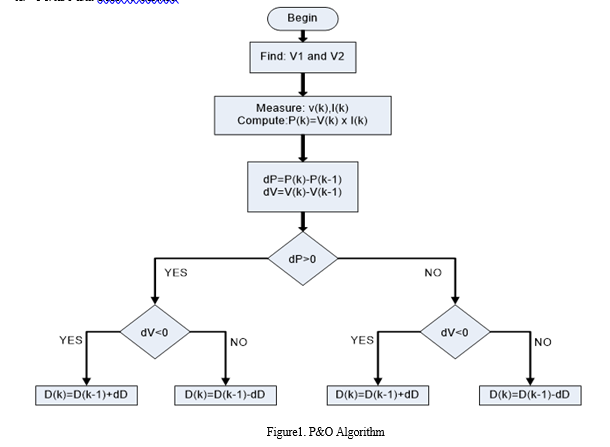
The Perturb and Observe technique gained popularity due to its ease of implementation in electronic circuits. It operates by iteratively adjusting specific parameters until it reaches the Maximum Power Point(MPP) of a solar photovoltaic panel. Essentially, this keeps tweaking variables and observing the resulting power output, comparing it to previous values to determine if adjustments are needed to approach the MPP. However, while P&O is simple to implement, traditional methods can sometimes suffer from issues like oscillations around the MPP and slow response times.
To address these limitations, a modified P&O approach has been developed. This enhanced version focuses on a specific portion of the power curve, typically about 10%, rather than considering the entire curve. By narrowing down the search space, this modified algorithm can more efficiently find the MPP, reducing oscillations and improving response time. Additionally, incorporating a digital signal processor (DSP) based controller further enhances the successfulness of the method.
- Advantages
Simplicity: The Perturb and Observe algorithm is easy to put it into practice, making it accessible even to engineers or hobbyists with less experience.
Real-time Performance: It operates in real-time and will adjust the operating point of the photovoltaic(PV) system promptly in response to environmental changing conditions.
Low Cost: Since it doesn't necessitate sophisticated hardware or significant computational resources, the P&O technique is more cost-effective to implement.
Wide Applicability: This can be applied to types of various photovoltaic(PV) systems, including those with different configurations and environmental conditions.
Reliability: Despite its simplicity, the P&O method generally provides reliable performance under typical operating conditions.
2. Limitations
Oscillations: Under swiftly shifting irradiance conditions, the P&O method may induce oscillations around the MPP, potentially resulting in energy losses and diminishing system efficiency.
Accuracy: It may not precisely track the MPP under partial shading conditions or non-linear temperature variations, which can impact the overall energy yield of the photovoltaic system.
Dependency on Perturbation Step Size: The effectiveness of the algorithm is influenced by the selection of the perturbation step size. An inappropriate step size could result in slower tracking or increased oscillations.
Sensitivity to Noise: The algorithm's performance can be affected by noise in sensor measurements or other sources, potentially leading to suboptimal operation.
Efficiency Losses: Due to its heuristic nature, the Perturb & Observe(P&O) method may not always achieve global maximum power point(MPP), resulting in some efficiency losses compared to more advanced MPPT algorithms under certain conditions.

B. Incremental Conductance (Inc Cond) Method
Another method, known as Incremental Conductance (IC), will offer a different approach to maximizing solar panel efficiency. The Incremental Conductance (IC) method modifies the terminal voltage of the photovoltaic panel by referencing the voltage associated with the MPP. It achieves by scrutinizing slope of the power curve and implementing adjustments accordingly. This approach proves effective as it dynamically monitors alterations in the power curve, ensuring efficiency is upheld, and ceasing adjustments once the MPP is attained.
- Advantages
Improved Tracking Accuracy: The Incremental Conductance (IC) method offers enhanced tracking precision compared to the P&O method, particularly in scenarios of swiftly fluctuating environmental conditions and partial shading.
Faster Convergence: It achieves faster convergence to the maximum power point compared to the Perturb & Observe (P&O) method, minimizing the duration spent operating away from the optimal power point and maximizing energy capture.
Adaptability to Variations: The algorithm is more adaptable to variations in solar irradiance and temperature, allowing for better performance in dynamic weather conditions.
Reduced Oscillations: Inc Cond typically exhibits fewer oscillations around the MPP, leading to smoother operation and potentially higher overall system efficiency.
Enhanced Efficiency: By dynamically adjusting the operating point based on changes in both voltage and current, the Incremental Conductance method can help maximize energy extraction from the photovoltaic panels.
2. Limitations:
Complexity: Unlike the simple setup of the Perturb & Observe method, implementing the Incremental Conductance algorithm is more complex, requiring additional computational resources and hardware.
Sensitivity to Model Parameters: Its performance is sensitive to the accuracy of the photovoltaic model parameters, requiring precise calibration for optimal operation.
Potential for Overshoot: In certain conditions, the Incremental Conductance method may exhibit overshoot or undershoot behavior around the MPP, which can lead to transient inefficiencies.
Higher Cost: Due to its increased complexity, implementing the Incremental Conductance method may entail higher costs in terms of hardware and development effort compared to simpler MPPT algorithms.
Not Universally Applicable: While generally effective, the performance of the Inc Cond method can vary depending on specific system configurations and environmental factors, limiting its universal
applicability.

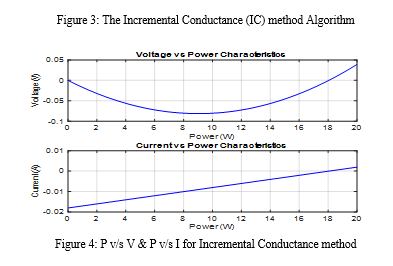
C. Constant voltage MPPT Method
The Constant voltage MPPT method or technique involves regulating the voltage of a solar panel according to the ambient temperature in its surroundings. This adjustment is made to optimize the panel's performance and it shows that it operates at its Maximum Power Point. Simplicity and minimal hardware requirements, making it cost-effective to implement are one of the advantages of this method. This method automatically modifies the reference voltage to accommodate changes in environmental conditions, ensuring that the panel operates efficiently regardless of temperature variations.
Among the various methods to achieve Maximum power point, constant voltage (CV) and constant current CI) techniques are considered the simplest and quickest. These techniques work on the premise of a linear correlation between the voltage (or current) at maximum power of the module and its open-circuit voltage (or short-circuit current). These methods operate under the assumption of a linear relationship between the voltage (or current) of the module at maximum power and its open-circuit voltage (or short-circuit current). However, limitation of these methods is they assume constant environmental conditions, which may not always hold true, leading to suboptimal performance.
Improved versions of these techniques incorporate online tracking algorithms, which continuously monitor open-circuit voltages and short-circuit currents to adjust parameters in real-time. This enhances the accuracy of the MPPT process, which ensures that the solar photovoltaic (PV) panel operates closer to the true MPP under varying environmental conditions.
- Advantages:
Simplicity: The Constant Voltage MPPT method is simple to implement when compared to other Maximum power point tracking (MPPT) algorithms, requiring less computational complexity & fewer hardware components.
Stability: It tends to provide stable operation under varying environmental conditions, as it maintains a constant voltage across the PV array.
Cost-Effectiveness: Due to its simplicity, the Constant Voltage method can be cost-effective to deploy, making it suitable for applications with budget constraints.
Compatibility: This method can be compatible with various types of PV systems and configurations, allowing for widespread adoption across different setups.
In certain situations, especially when the photovoltaic (PV) array maintains a steady voltage, the Constant Voltage MPPT technique can efficiently track the MPP without necessitating intricate algorithms.
2. Limitations:
Suboptimal Performance: The Constant Voltage method may not always achieve the highest power output compared to more advanced MPPT techniques, especially under rapidly changing irradiance or temperature conditions.
Limited Efficiency: It might lead to energy losses under certain conditions, particularly when the PV array operates away from its optimal voltage due to variations in irradiance or shading.
Dependency on Operating Point: The efficacy of this approach primarily hinges on the initial operating point of the PV array, potentially constraining its ability to adapt to dynamic shifts in environmental conditions.
Inflexibility: Constant Voltage MPPT may lack the flexibility to adapt to the non-linear characteristics of PV modules or changes in the system configuration, potentially limiting its overall efficiency.
Potential for Overheating: Maintaining a constant voltage across the PV array can sometimes lead to increased heat dissipation, especially in high irradiance conditions, which may impact the longevity of the system components.
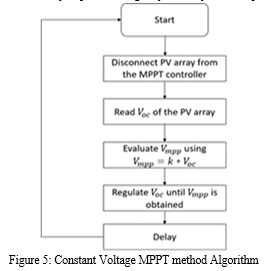
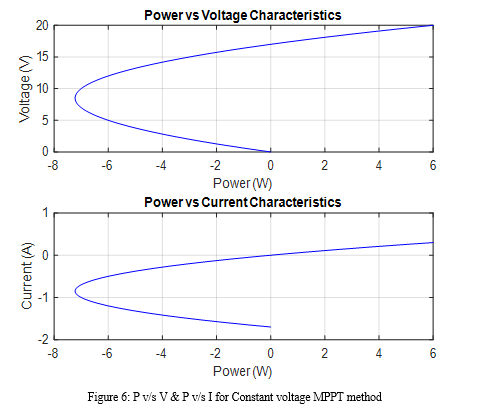
D. Fibonacci algorithm-based search MPP
One approach to MPPT is using the Fibonacci algorithm. The Fibonacci search algorithm is a numerical optimization technique based on the Fibonacci sequence is a sequence of numbers where each number is the sum of the two numbers preceding it. For example, it starts with 0 and 1, and each subsequent number is the sum of previous two numbers. In this context of MPPT, the Fibonacci search algorithm will be used to approach the maximum power point (MPP) iteratively.
Here's how it works:
- Initialization: Start with two initial guesses for the maximum power point, P1 and P2, such that P1 < P2.
- Calculate the Next Point: Calculate a new guess, P3, using the Fibonacci sequence. This is done by selecting a Fibonacci number (n) and calculating the next point using the formula P3 = P1 + (Fib(n-1)/Fib(n)) * (P2 - P1), where Fib(n) represents the nth Fibonacci number.
- Evaluate Power: Measure the power output of the solar panel at point P3.
- Update Points: Update points P1 and P2 based on the measured power output. If the output power at P3 is more than the output power at P1, then set P1 = P3; otherwise, set P2 = P3.
- Repeat: Until a termination condition is met steps 2-4 are repeated (e.g., reaching a predefined tolerance level or maximum number of iterations).
The Fibonacci search algorithm converges towards the maximum power point in a logarithmic number of steps, making it efficient for MPPT applications. The algorithm continually refines the operating point of the solar photovoltaic panel by utilizing measured output power.
This iterative process aims which will ensure that the solar photovoltaic(PV) panel operates as much close as possible to its MPP, even when environmental conditions fluctuate. It's crucial to acknowledge that while the Fibonacci algorithm serves as one method for MPPT, various other algorithms exist, including P&O, Inc Cond, and HC, each with its own set of strengths and weaknesses. Selecting the appropriate algorithm will depend on factors such as cost, system complexity, and performance criteria.
- Advantages:
Efficient Exploration: The Fibonacci algorithm-based search efficiently explores the search space by utilizing the Fibonacci sequence to determine search points, allowing for a systematic approach to finding the maximum power point.
Global Optimization: This is capable of converging to global MPP, ensuring optimal power output from the photovoltaic system under varying environmental conditions.
Simplicity: The algorithm is very simple to implement when compared to some other optimization techniques, requiring fewer computational resources and less complex algorithms.
Adaptability: The Fibonacci algorithm-based search can adapt to changes in some environmental parameters such as temperature and solar irradiance, ensuring effective MPPT in dynamic operating conditions.
Low Computational Overhead: It typically involves low computational overhead, making it suitable for implementation in resource-constrained environments or embedded systems.
2. Limitations:
Convergence Speed: The Fibonacci algorithm-based search may converge more slowly compared to some other optimization techniques, especially in scenarios with large search spaces or complex system configurations.
Sensitivity to Initial Parameters: Its performance can be sensitive to the selection of initial parameters and search ranges, requiring careful tuning for optimal results in different PV system setups.
Potential for Suboptimal Solutions: In certain cases, the algorithm may converge to suboptimal solutions or local maxima/minima rather than the global maximum power point, leading to reduced MPPT efficiency.
Limited Scalability: The scalability of the algorithm may be limited when applied to large-scale PV systems with numerous modules, as the computational complexity may increase significantly.
Lack of Robustness: The Fibonacci algorithm-based search may struggle to handle noisy or uncertain environmental data, affecting its robustness and reliability in real-world applications.
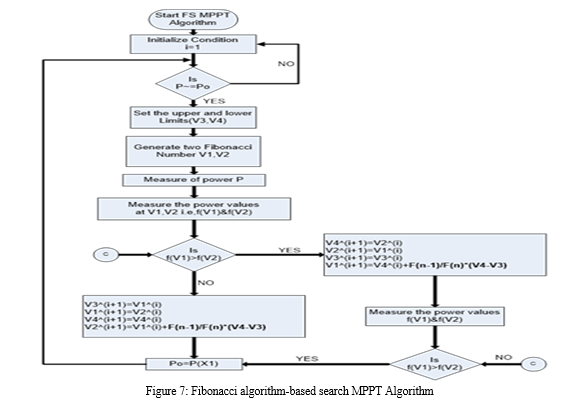
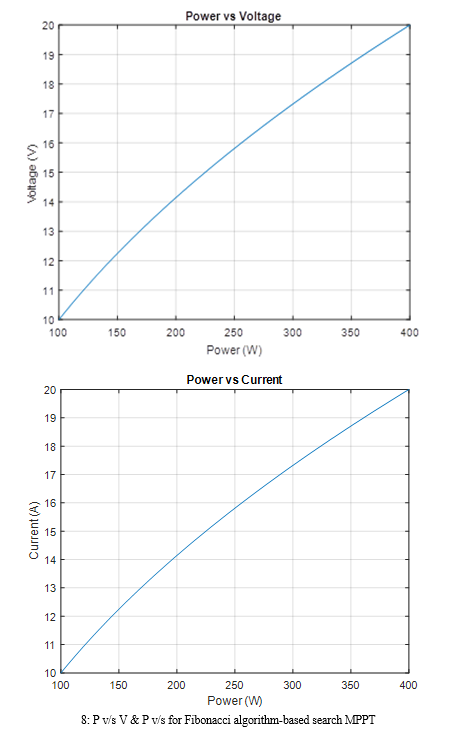
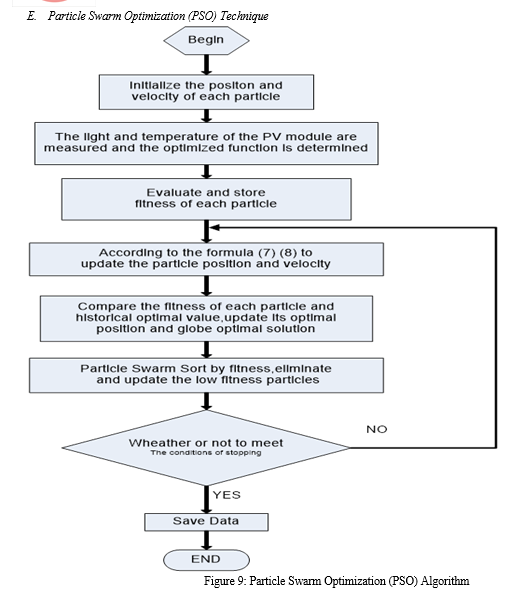
Presently, the dominant Maximum power point tracking algorithms demands lighting conditions mainly consist of Particle Swarm Optimization and Genetic Algorithms. Among these, Particle Swarm Optimization is particularly favoured due to its efficient ability to find solutions quickly & it’s simplicity. However, traditional PSO methods may encounter premature convergence issues during the search process, especially in scenarios with multiple output power peaks from the PV array. Additionally, the performance of PSO tends to decline as the search progresses.
To address these challenges, a novel approach combining the concept of Natural Selection with traditional MPPT algorithms has been proposed. This technique seeks to improve the effectiveness of PSO in discovering optimal solutions by substituting the velocity and position of less successful particles with those of better-performing ones during each iteration. This strategy effectively prevents premature convergence and improves the overall search speed and accuracy.
In the PSO algorithm, each particle in the N-dimensional search space seeks to optimize a specific function using its fitness value and velocity vector to determine its flight direction and distance. Moreover, individual particles retain information about their best-known position as well as the overall best position discovered by the entire group.
The updated formulas for position and velocity incorporate factors such as inertia weight (w), positive learning factors (c1 and c2), and random numbers (r1 and r2).
- Advantages:
Global Optimization: PSO excels in finding the global maximum power point (MPP) by iteratively adjusting parameters, and leveraging the collective intelligence of particles within the swarm.
Adaptability: It can adapt to changes in environmental conditions, such as varying irradiance levels & temperatures, enabling efficient tracking of the MPP under dynamic operating conditions.
Fast Convergence: PSO typically converges to the optimal solution relatively quickly, leading to faster tracking of the MPP compared to some traditional methods.
Parallelism: Particle Swarm Optimization (PSO) is inherently parallelizable, which allows efficient implementation on parallel computing platforms, which can accelerate the optimization process, especially for large-scale Photovoltaic systems.
Robustness: PSO exhibits resilience against getting stuck in local optimal solutions and demonstrates effectiveness in dealing with non-linear and non-convex optimization challenges. This makes PSO suitable for various MPPT scenarios, expanding its usability significantly.
2. Limitations:
Parameter Sensitivity: PSO performance can be sensitive to its control parameters, such as acceleration coefficients and inertia weight, which will require fine-tuning for optimal operation in different environments.
Premature Convergence: In certain situations, PSO may prematurely converge to suboptimal solutions, particularly in complex or noisy search spaces, leading to reduced tracking accuracy.
Computational Overhead: Implementing PSO may require significant computational resources, especially for systems with large numbers of particles or complex fitness functions, potentially increasing the computational overhead.
Memory Requirement: The memory requirement of PSO scales with the number of particles in the swarm, which can become prohibitive for systems with a large number of PV modules or when memory resources are limited.
Lack of Determinism: PSO lacks determinism due to its stochastic nature, making it difficult to guarantee the same solution across multiple runs, which may pose challenges for reproducibility and reliability in some applications.
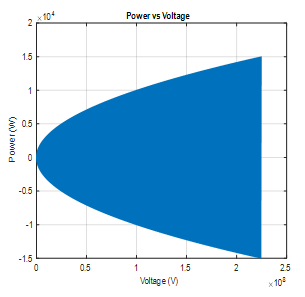

Conclusion
This review paper examines five distinct MPPT methods, namely conventional, intelligent, optimization, and hybrid approaches. Conventional methods are effective in optimal power tracking under full sunshine but struggle with partial shading scenarios. optimization and Intelligent methods offer superior global MPP tracking under partial shading, albeit with increased complexity and cost. Despite their advantages, these methods which are advanced are generally much more expensive than conventional ones, such as P&O, which remains widely used in industry MPPT controller designs. However, conventional methods exhibit slower response times and less stability compared to optimization, intelligent, and hybrid techniques. This study offers valuable insights which will select the most suitable MPPT technique based on priorities & specific requirements.
References
[1] Xie, Y., Xu, Y., Wang, C., Zhang, P., and Zhou, X. conducted maximum power point tracking review algorithms for photovoltaic(PV) systems under both non-uniform and uniform irradiances. This review was published in Renewable and Sustainable Energy Reviews in 2022, Volume 161, with the DOI: 10.1016/j.rser.2022.105222. [2] Ramy, H., El-Khodary, A., Abdelsalam, A. K., and El-Tamaly, H. M. conducted a review on maximum power point tracking(MPPT) algorithms for PV systems, that was published in Emerald Insight in 2021, Volume 15, Issue 4, with the DOI: 10.1108/EJIMCO-02-2021-0031. [3] Femia, N., Petrone, G., Spagnuolo, G., and Vitelli, M. reviewed maximum power point tracking(MPPT) algorithms for photovoltaic(PV) applications, published in IEEE Transactions on Power Electronics in 2006, Volume 21, Issue 3, with the DOI: 10.1109/TPEL.2006.870367. [4] Tripathi, M. P., Singh, M., Dubey, S. P., and Garg, A. conducted a comprehensive review on maximum power point tracking(MPPT) techniques for photovoltaic systems, published in Renewable Energy in 2023, Volume 172, with the DOI: 10.1016/j.renene.2023.02.044. [5] El-Khodary, M. E. A., El-Kholy, A. A., Youssef, A. M., and Abdelsalam, A. K. introduced a novel model predictive control (MPC) based maximum power point tracking (MPPT) algorithm for efficient tracking under conditions of partial shading. This research was published in 2023. [6] A Novel Hybrid MPPT Algorithm for Photovoltaic Systems Based on Fractional Open-Circuit Voltage and Particle Swarm Optimization (S. Ahmed, A. Q. Ansari, & S. N. Singh, 2023): Proposes a hybrid MPPT algorithm combining fractional open-circuit voltage estimation and particle swarm optimization for improved tracking performance. [7] Li, D., Zhang, Y., Yang, P., Zhang, Y., and Li, Q. devised an adaptive MPPT algorithm for photovoltaic systems by combining hybrid artificial bee colony and salp swarm optimization techniques. Their approach, presented in 2023, aims to achieve rapid and precise tracking. [8] Singh, B., Singh, M., and Tripathi, M. P. introduced a novel MPPT technique designed specifically for Photovoltaic(PV) partially shaded systems. Their method, developed in 2023, integrates a modified fractional short-circuit(SC) current approach with Hill Climbing(HC) algorithm to improve efficiency under partial shading conditions. [9] H. Patel and V. Agarwal, \"Maximum power point tracking(MPPT) scheme for PV systems operating under partially shaded conditions,\" IEEE Transactions on Industrial Electronics, vol. 55, no. 4, pp. 1689-1698, April 2008. [10] S. K. Jain and V. Agarwal introduced a novel algorithm for swiftly tracking the approximate maximum power point in photovoltaic systems in their paper titled \"A novel algorithm for rapid tracking of approximate maximum power point(MPP) in photovoltaic(PV) systems,\" published in IEEE Power Electronics Letters, March 2004, Volume 2, Issue 1, pages 16-19. [11] M. Veerachary, T. Senjyu, and K. Uezato proposed a method for maximum power point tracking(MPPT) in coupled-inductor interleaved-boost-converter-supplied PV systems utilizing neural network and fuzzy controller techniques. This research was documented in their paper \"Neural-network(NN)-based maximum power point tracking(MPPT) of coupled-inductor interleaved-boost-converter-supplied photovoltaic(PV) system using fuzzy controller,\" published in IEEE Transactions on Industrial Electronics, August 2005, Volume 52, Issue 4, pages 1129-1138. [12] S. Jain, V. Agarwal, and M. K. Dubey, \"A single-sensor-based Maximum power point tracking (MPPT) for photovoltaic(PV) systems operating under partially shaded conditions,\" IEEE Transactions on Energy Conversion, vol. 27, no. 4, pp. 1022-1030, December 2012. [13] Jin, H., Jung, S., and Choi, Y. introduced a novel adaptive Maximum power point tracking (MPPT) technique for photovoltaic systems in their paper titled \"A novel adaptive MPPT method for photovoltaic(PV) systems,\" published in IEEE Transactions on Industrial Electronics, June 2011, Volume 58, Issue 6, pages 2427-2434. [14] Zhai, Y., Li, Z., and Hu, C. proposed an enhanced variable step-size incremental conductance method for photovoltaic systems in their paper \"An improved variable step-size incremental conductance method for photovoltaic systems,\" published in IEEE Transactions on Industrial Electronics, August 2012, Volume 59, Issue 8, pages 3118-3128 [15] Kennedy, J., and Eberhart, R. introduced Particle Swarm Optimization in their paper titled \"Particle swarm optimization(PSO),\" presented at the IEEE International Conference on Neural Networks in December 1995. [16] Zhang, Y., Jiang, Y., and Zhu, J. proposed a novel Maximum power point tracking(MPPT) algorithm utilizing Particle Swarm Optimization(PSO) for PV systems in their paper titled \"A novel Maximum power point tracking (MPPT) algorithm based on particle swarm optimization for photovoltaic(PV) systems,\" published in IEEE Transactions on Sustainable Energy, April 2014, Volume 5, Issue 2, pages 395-402. [17] Huang, S. H., Wang, T. Y., and Tu, C. S. developed a novel maximum power point(MPP)tracker utilizing fuzzy control for photovoltaic(PV) energy conversion systems. This research was documented in their paper titled \"A novel maximum power point(MPP) tracker based on fuzzy control for photovoltaic(PV) energy conversion systems,\" published in IEEE Transactions on Industrial Electronics, February 2002, Volume 49, Issue 1, pages 217-225. [18] Xiao, W., Ye, D., and Zhang, Z. proposed an MPPT method for photovoltaic(PV) systems utilizing an enhanced Fibonacci search technique. Their research was documented in the paper \" maximum power point tracking(MPPT) based on improved Fibonacci search method for PV systems,\" published in IEEE Transactions on Power Electronics in February 2017, Volume 32, Issue 2, pages 1480-1491.
Copyright
Copyright © 2024 Mohammed Abdullah, Dr. S. V. Padmavathi. This is an open access article distributed under the Creative Commons Attribution License, which permits unrestricted use, distribution, and reproduction in any medium, provided the original work is properly cited.

Download Paper
Paper Id : IJRASET59274
Publish Date : 2024-03-21
ISSN : 2321-9653
Publisher Name : IJRASET
DOI Link : Click Here
 Submit Paper Online
Submit Paper Online

